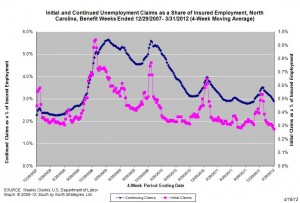Payrolls Flat, Unemployment Down In March
CHAPEL HILL (April 20, 2012) – Payroll employment levels in North Carolina held steady in March, while the statewide unemployment rate fell to the lowest level recorded over the last three years. Despite the overall growth in payrolls and the drop in unemployment posted during the first quarter of 2012, unemployment remains elevated, and the current rate of job growth is unlikely to close the state’s sizable job gap anytime soon. These findings come from new data released by the Labor and Economic Analysis Division of the NC Department of Commerce.
“During the first three months of the year, North Carolina employers added 26,700 more jobs than they cut, which helped push down the unemployment rate to the lowest level seen in three years,” said John Quinterno, a principal with South by North Strategies, Ltd., a research firm specializing in economic and social policy. “Compared to last December, North Carolina has more jobs, a larger labor force, more employed persons, fewer unemployed individuals, and a lower unemployment rate. The share of the adult population with a job, though still extremely depressed, also rose during the first part of the year.”
In March, North Carolina employers cut 1,300 more payroll jobs than they added (+/- 0 percent). Private sector payroll levels essentially held steady, (-300, +/- 0 percent), while the public sector eliminated 1,000 more positions than it gained (-0.1 percent), due chiefly to reductions by state government. Within the private sector, construction shed the most jobs, (-2,900, -1.7 percent), followed by professional and business services (-1,300, -0.3 percent), and other services (-800, -0.5 percent). Financial activities netted the most jobs (+1,600, +0.8 percent), followed by leisure and hospitality services (+1,300, +0.3 percent), and trade, transportation, and utilities (+1,000, +0.1 percent).
A negative revision to the February 2012 payroll data found that the state gained 2,200 fewer jobs than first reported (+6,100 versus +8,300). With that revision, North Carolina now has, on net, 217,800 fewer payroll positions (-5.2 percent) than it had in December 2007. Since bottoming out in February 2010, the state has netted an average of 4,340 payroll jobs per month, resulting in a cumulative gain of 108,500 positions (+2.8 percent).
“Over the past two years, North Carolina has managed to close some of the job gap caused by the recent recession,” noted Quinterno. “Since last July, the job gap has fallen by a full percentage point, yet when compared to December 2007, North Carolina still has fewer payroll jobs in every major private industry sector except for educational and health services and professional and business services. A full labor market recovery remains a distant goal.”
The household data for March also point to a labor market that is far from robust. Positive developments included a small increase in the number of employed individuals (+4,240, +0.1 percent), a decline in the number of unemployed persons (-12,092, -2.6 percent), and a drop in the unemployment rate to 9.7 percent, the lowest level recorded over the past three years.
Nevertheless, joblessness remained widespread in March. There were almost twice as many unemployed North Carolinians in March 2012 as there were in December 2007, and the statewide unemployment rate was 4.7 percentage points greater than it was some four years ago. In fact, the monthly statewide unemployment rate has exceeded 10 percent in 35 of the last 37 months. Moreover, the size of the state’s labor force fell by 7,852 individuals (-0.2 percent) in March.
“Despite the improvements recorded during the first quarter of 2012, North Carolina’s labor market remains in fragile condition,” cautioned Quinterno. “Particularly worrisome is the fact that payroll employment growth slowed over the quarter, with each month’s statistics slightly worse than the ones from the preceding month. In no way are recent improvements signs that all is well in the labor market.”


 Email Sign-Up
Email Sign-Up RSS Feed
RSS Feed